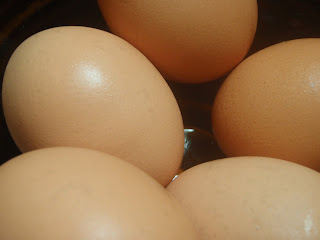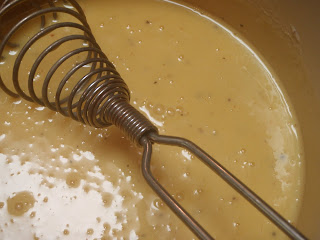This is a recipe I'd been wanting to try a while, but it never quite happened.
I like to make souffles a lot (as long as they happen to be cooperative souffles), and I happened to be on a cheese kick when I finally tried it.
You see, the only souffles I had made up to this particular point had been sweet, never savory.
I know bleu cheese isn't everyone's cup of tea- it can be fairly strong and sharp... another one of those "love it or hate it" types of foods. Penicillium cultures are added to give the cheese it's flavor as well as lovely veins and marbling (other than as a possible exclamation from a phlebotomist, this may happen to be one of the only times veins can be referred to as "lovely"... I just had to say that here, I think it might have been a requirement).
In the nineteenth century, Roquefort cheesemakers found that they could speed the production of bleu cheese ripening by baking loaves of rye bread and adding a little powdered mold. The moisture in the bread made it a good place to grow mold. The loaves were completely molded through after about two weeks, the loaves were dried and ground, and later added to cheese.
It sounds like a science experiment!
It sounds like a science experiment!
The cheeses spend some time in dark, cool caves to age a little.
An interesting story about Roquefort deals with the fact that it's almost always shipped in half-wheels. It's traditionally believed to be this way because of Charlemagne. He stopped in the area and was served bleu cheese by the abbot. Charlemagne saw the blue bits in the cheese, took out his knife, and started removing them. The abbot gently told him the blue parts were considered the best parts. Charlemagne loved the cheese and asked to be sent two wagonloads a year. To ensure that he could see he had the most flavorful, best cheese, he instructed the abbot to split the wheels in half.
The flavor of a specific bleu cheese (Roquefort, Stilton, Maytag, Gorgonzola...) depends on the type of milk used as well as aging time and terrior. Two products from two different locations can taste very different from one another (depending on climate, soil, "air" or the general area something is produced in) although the steps taken to produce said things may be exactly the same.
Examples include coffees, chocolate, vanilla, wine, and cheese.
It's very interesting...
The production of bleu cheese requires humidity and moderate temperatures, so it can't be created everywhere. The mold was originally an accident that became purposeful.
This one is adapted from Ina Garten- very miniscule adaptations.
When you make souffles, you'll want to serve them as soon as possible. The cooler temperature outside the oven causes souffles to begin deflating as soon as they come out (a tip in case you plan to photograph your food). This is also the reason behind not opening the oven to peek at a souffle- the rush of cool air isn't conducive to a rising souffle.
Bleu Cheese Soufflé
serves 2-4
3 T unsalted butter, plus extra for greasing the dish
1/4 c finely grated Parmesan cheese, plus extra for sprinkling
3 T flour
1 c scalded milk
kosher salt and finely ground black pepper
pinch of cayenne pepper
large pinch of freshly ground nutmeg
4 XL egg yolks, at room temperature
3 oz good bleu cheese, chopped
5 XL egg whites, at room temperature
1/8 t white vinegar
Preheat oven to 400 degrees F. Butter the inside of an 8-cup souffle dish (7 1/2 inches in diameter x 3 1/4 inches deep) and sprinkle evenly with Parmesan.
Melt the butter in a small saucepan over low heat. With a wooden spoon stir in the flour and cook, stirring constantly for 2 minutes. Off the heat whisk in the hot milk, 1/2 t salt, 1/2 t pepper, cayenne and nutmeg. Return to low heat and cook, whisking constantly, for 1 minute, until smooth and thick.
Off the heat, while the mixture is still hot, whisk in egg yolks one at a time. Stir in the bleu cheese and the 1/4 c Parmesan, and transfer to a large mixing bowl.
Put the egg whites, white vinegar, and a pinch of salt in the bowl of an electric mixer fitted with a whisk attachment. Beat on low speed 1 minute to incorporate ingredients, on medium speed 1 minute, then finally on high speed until they form firm, glossy peaks.
Whisk one quarter of the egg whites into the cheese sauce to lighten, and then carefully fold in the rest. You want it incorporated, but don't over stir.
Pour the mixture into the prepared souffle dish then smooth the top with a spatula. Draw a large circle on top with the spatula to help the souffle rise evenly, and place in the middle of the oven. Turn the temperature down to 375 degrees. Bake for 30-35 mintues until puffed and brown. Serve immediately.


















Sad to say, Natalie, I'm not a lover of bleu cheese... I do like most other cheeses though. Would this work with others; what would you suggest?
ReplyDeleteJust use a cheese you like better- cheddar, gruyere...grate about 3 oz or so of your chosen cheese.
ReplyDeleteI think the biggest thing would be consistency here, make your cheese sauce and fold in the egg whites.
Try the seasonings here or maybe add some chopped fresh thyme.
BEEEYOUTIFULL souffle picture....
ReplyDelete